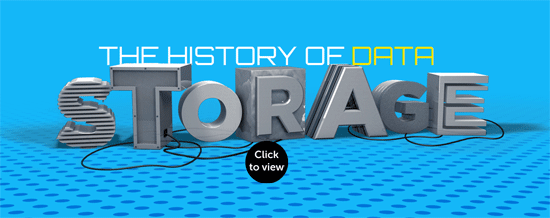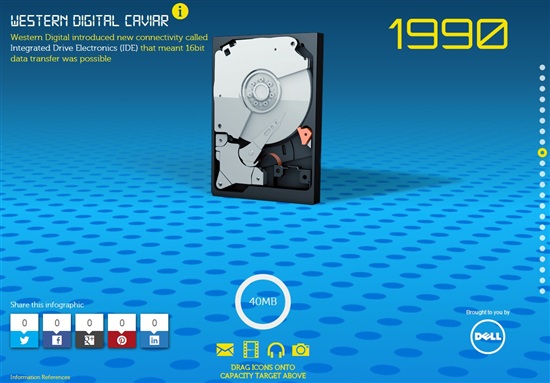Data storage has been a serious business from the earliest days of computing and remains so to this day. Things have changed though since in the 1950s when IBM launched its 305 RAMAC, which could give you only 3.75MB of storage capacity despite weighing in at over a tonne!
With the introduction of ever-more sleek and slender products, data storage artefacts have steadily shrunk over the past half century or so but perhaps the biggest shift is only just upon us with Dell launching the Ophelia and effectively delivering unlimited storage via the cloud.
Visit our data storage timeline for an interactive run down.
Where It All Began
What passed for cutting edge data storage technology during the 1950s would take a truck to transport and offered precious little storage space. The first removable hard drive was introduced back in 1962 when IBM launched the snappily-titled 1311. The fact that it was removable however didn’t mean it was particularly portable with the 1311 measuring in at roughly the same dimensions as jukebox.
Of course, all stories have to start somewhere and you have to take your hat off to these early pioneers in data storage. In fact, what might look like slow and sporadic progress through the ‘50s and ‘60s was nonetheless game-changing and thoroughly ground-breaking.
The Next Steps
The 1970s saw further progress on various fronts as far as data storage is concerned with Shugart Associates coming up with the world’s first floppy disk in 1976 and IBM offering as much as 571MB of storage capacity with its 3370.
The problem though was that the famous floppy disks could only cope with up to 360KB of data, while IBM’s 571MB powerhouse was about the size of a half dozen filing cabinets.
The ‘80s and ‘90s
The 1980s and ‘90s saw evolution on several fronts too. The floppy disk was reimagined and supersized with varying but generally very useful results while the very first hard disk drives began to emerge in the very early 1980s. By the middle of the decade the speed with which data could be transferred became the biggest game in town and before long our computers started to become genuinely portable and the laptop era was born.
Power Vs Portability
In recent years the two ends of the data storage market have gradually succeeded in giving us as consumers and businesses either more storage capacity or greater portability. But now it looks like these two elements have finally converged in the form of the very latest of Dell data storage solutions and the Ophelia, which has no storage limits at all and offers personal cloud computing access via a USB stick.
Use the code below to embed the graphic:
<a href=”http://techpageone.dell.com/history-of-data-storage/“><img src=”http://techpageone.dell.com/history-of-data-storage/images/static.jpg” alt=”The History of Data Storage” width=”630″ /></a><p>The History of Data Storage</p>

